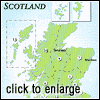|
Dumfries and Galloway
 The area stretching from Scotland's south-western tip
to the border with England is perhaps the most undiscovered in all the country. Now
known as Dumfries and Galloway region, it remained autonomous up until the eleventh
century, more affiliated with the Vikings than the Scots.
The area stretching from Scotland's south-western tip
to the border with England is perhaps the most undiscovered in all the country. Now
known as Dumfries and Galloway region, it remained autonomous up until the eleventh
century, more affiliated with the Vikings than the Scots.
By the fifteenth century it was gradually integrated
into a unified Scotland. To look at, it is a soft, green, placid area but this belies
the violent events of Dumfries and Galloway's history. Galloway, as it was known
then, was a stronghold for the Covenanters who resisted the influence of Episcopalian
dogma and paid the price.
The Gaelic translation of Galloway means 'Land of
the Stranger,' but it certainly is a friendly place that makes visitors feel most
welcome. Fishing, farming and tourism make up the bulk of the local economy. It is
set apart from the main tourist routes. There are no motorways crossing it apart
from the M74 going north and south on its eastern perimeter. Outlined between the
Firth of Clyde and the Solway Firth, the main access routes are the A77 from Glasgow,
the A75 roughly following the Solway Firth from Gretna to Stranraer, and the A76
dropping down from Kilmarnock to Dumfries.
Stranraer is a nodal point in the area, mainly because
of its connections across the sea to Ireland. Stranraer's economy, once based on
its role as a market centre, has increasingly turned to the ferry traffic that constantly
pours in and out of town. B&B's and small hotels line the foreshore at Harbour
Street and Market Street and the town centre has a few eating places geared to passing
trade. There is little else to recommend, but it is a good accommodation base if
you wish to explore this area.
Rhinns
The long, rocky-shored annex of land adhering to Galloway
to the west is known as the Rhinns. There are plenty of short tours available around
this near-island, but most people head first-of-all along the A77 from Stranraer
to the harbour town of Portpatrick. This is a quintessential holiday retreat with
charming streets and cottages and a tranquil harbour backed by small cliffs.
 As opposed to Stranraer, Portpatrick was once the main port
for travellers, goods and livestock to and from Northern Ireland - only 22 miles
(35km) away. It lost out to the more sheltered facilities at Stranraer when sails
were replaced by steam engines. As opposed to Stranraer, Portpatrick was once the main port
for travellers, goods and livestock to and from Northern Ireland - only 22 miles
(35km) away. It lost out to the more sheltered facilities at Stranraer when sails
were replaced by steam engines.
Portpatrick's centre is a place to leave the car and
wander amongst craft shops and cafes to enjoy the refreshing air that blows off the
Irish Sea. There is a fascinating museum called Little Wheels where model enthusiasts
of all kinds can gather and relive childhood memories. It is from Portpatrick that
the Southern Upland Way commences its trail across Scotland's borderlands. Above
town are two good golf courses, the Dunskey course being the more challenging.
A round-trip tour of the Rhinns to the Mull of Galloway
covers some 50 miles (80 km) from Stranraer. The main attraction of this largely
dairy herd inhabited and gorse bush encrusted area is its coast with secluded stretches
of sand and pleasant little harbour villages such as Port Logan. Here you find Logan
Botanic Gardens, an annex of Edinburgh's Royal Botanic Gardens with sub-tropical
plants such as tree ferns and cabbage palms flourishing outdoors in the mild Gulf
Stream climate.
The A75 to Dumfries
Returning to the main route from Stranraer, 3 miles
(5km) east of there on the A75 is Castle Kennedy, best known for its 75 acres of
carefully landscaped gardens that are set out on a thin strip of land between the
Black Loch and the White Loch. The best time to visit here is in late spring when
thirty-seven varieties of rhododendrons and azaleas are in their prime.
Glenluce Abbey just off the A75 travelling east is
the remains of a twelfth century abbey and well worth stopping for, with its magnificent
fifteenth century Chapter House.
A thirteenth century wizard, Michael Scott, supposedly
saved the Glenluce community when he enticed 'the plague' into the church vault and
left it there until it starved to death. The recently opened Pilgrim's Way traces
the medieval route used by religious travellers which commences at Glenluce Abbey
and wound through the Machars to the important religious site at Whithorn.
The A75 cuts directly across this area called the
Machars to Newton Stewart. The Machars is rather flat with the two main towns of
Whithorn and Wigtown being its best enticements.
Whithorn is the true birthplace of Christianity in
Scotland.
St Ninian, a fourth century bishop, perhaps a local
man who had gone to Rome to become consecrated, landed here in AD397. He built a
church called Candida Casa or the White House and set about converting the Southern
Picts and Britons.
A priory was built on the site of the first church
and the site became a special place for pilgrims for many centuries up until the
time of the Reformation. The history of the original church, the priory and Christianity
in Britain is well documented in a small museum nearby.
The Whithorn Dig is currently being carried on around
the site of the early church to further reveal the area's important ecclesiastical
connections. Guided tours around this are essential to grasp the full archaeological
significance.
A short excursion to the Isle of Whithorn, 3 miles
(5km) further south-east, is worthwhile and well sign-posted from Whithorn. There
is a small chapel dedicated to St Ninian and it was here that pilgrims would land,
having crossed the Solway Firth from England or from further abroad.
St Ninian's Cave, some 3 miles (5km) from Whithorn
on the west side of the Machars and a walk to the shore from the car park at Kidsdale
Farm, is an intriguing place where St Ninian is supposed to have sought repose. There
are several crosses carved into the rock inside the cave.
Wigtown, 11 miles (18km) north of Whithorn on the
A746, is an unsophisticated little holiday town. From the hill on which the town
is built you can see Bladnoch Bay and the stone pillar that marks the spot where
two martyrs, Margaret McLachland and Margaret Wilson, were tied to stakes and drowned
as the tide rose around them. Their crime was attending the illegal Covenanter's
prayer meetings and opposing Episcopalians.
Returning to the A75 the typical Galloway town of
Newton Stewart sits on the banks of the River Creel The local museum is located in
St John's Church on York Road and contains information on the district's history.
Game fishing is popular in this area and permits can be obtained from the Creebridge
House Hotel near the old bridge.
The best access point into Galloway Forest Park is
via the A714 north of Newton Stewart to Glen Trool Village then following the minor
road to Glen Trool Lodge. Galloway Forest Park comprises of some 190,000 acres (76,000
hectares) of hills, lochs, moorland and forest that is a haven for wildlife. The
Merrick at 2,766ft (844m) is the highest peak in the south of Scotland. It is worth
the steady, fairly demanding hike to enjoy the views over Glen Trool. Start at the
car park at Bruce's Stone.
The route to New Galloway called the Queen's Way passes
through some of the Galloway Forest Park where the Forestry Commission have mapped
out various walking trails near to the road.
The A75 branches south and east towards Gatehouse
of Fleet and Kirkcudbright with Castle Douglas further east. At Creetown, some 6
miles (l0km) south of Newton Stewart, is the Gem Rock Museum, a cavern of over 10,000
specimens of gem stones, crystals and minerals from around the world.
The village of Gatehouse of Fleet, a further 12 miles
(19km) along the coast of Wigtown Bay, is a good example of late eighteenth century
town planning spurred on by the rise of a cotton industry that was developed by James
Murray. This industrial boom lasted for nearly 100 years before other towns took
over and Gatehouse slipped back into obscurity. The Mill-on-the-Fleet Museum gives
credit to the town's hey-day.
Kirkcudbright, pronounced 'Kircoobrie,' is a delightful
centre of fishing and agriculture as well as tourism. MacLellan's Castle is in the
centre of town, a fine model of Scottish fortified architecture. The detached little
town has been an enclave for artists and still is a draw for landscape painters.
The Tolbooth Art Centre features an audio-visual show,
permanent art exhibition, artists studios, a café and shop. The Stewartry
Museum next door is a traditional museum reflecting the human and natural history
of the eastern part of Galloway.
On the Lochfergus Plantation above the town is the
Kirkcudbright Wildlife Park with over 100 animals including many native Scottish
species. A few miles south there is a pleasant drive to Brighouse Bay that has one
of the best caravan/holiday parks in the UK. It also has its own excellent 9-hole
golf course soon to be extended to 18.
Dundrennan Abbey graces the southern loop of the A711
to Dalbeattie and Castle Douglas, a ruin of a sizeable Cistercian Abbey founded in
1142. In 1568, Mary Queen of Scots spent her last night in Scotland here before she
sailed for London and execution.
Threave Gardens and Wild Fowl Refuge, just west of
Castle Douglas, set in 60 acres (24 hectares) is the training grounds of the National
Trust for Scotland's horticulturists. There is a walled garden and green-houses surrounded
by various peat, rock and woodland garden projects. The Wildlife Refuge on the marshy
banks of the River Dee is equipped with observation points from which to observe
several species of duck and geese.
 Threave Castle, a short distance away, is reached by a path
of around a half mile's walk from a farmyard car park. Visitors wishing to cross
the water to the castle have to ring a bell to summon the boatman. Threave Castle, a short distance away, is reached by a path
of around a half mile's walk from a farmyard car park. Visitors wishing to cross
the water to the castle have to ring a bell to summon the boatman.
Castle Douglas is another planned village of the eighteenth
century, laid out by William Douglas, a local lad who made good in West Indies trading.
His ambitions included transforming Castle Douglas into a prosperous centre for commerce
and industry along with a canal system serving this part of Galloway, neither of
which came to full fruition.
West of Dumfries
The A710 and A711 meeting at Dalbeattie form a final
lobe on the Solway Firth's north coast that makes a good day's tour from the nearby
centre of Dumfries. Passing through the Dalbeattie Forest to the hamlets of Kippford
and Colvend, the route offers some breathtaking views over the village of Sandyhills
to the wide Mersehead Sands.
The village of Southerness, set on a point, is popular
as a holiday and caravanning centre and has probably the best golf course in the
south-west. There are magnificent beach-side walks here stretching for miles in either
direction.
Eight miles (13km) from Dumfries in the tiny village
of New Abbey is 'Dulce Cor' or Sweetheart Abbey, one of the most elegant medieval
buildings of this area and the last Cistercian foundation in Scotland. New Abbey
village itself is very gracious with delightful cottages lining the main road and
an endearing village centre that gets congested with any more than four parked cars.
There is ample parking next to the abbey from which to explore the village and the
abbey ruins.
Also nearby is Shambellie House with its museum of
costume, an elegant country house that displays period costume, accessories, furniture
and paintings.
Dumfries
The central community of Dumfries and Galloway is
Dumfries, a red-sandstoned town of sturdy character beside the River Nith. Known
as the 'Queen of the South' it became established as a seaport and trading centre
from the Middle Ages.
Being close to the English Border, it was regularly
invaded and flattened, especially during the fifteenth and sixteenth centuries. Despite
this it has remained important as the focus of this area's agricultural prosperity.
Burns House, where he spent his last three years before
his death in 1796, is found in what is now called Burns Street, near the southern
end of the High Street. Stop at the Globe Inn on the way, one of Burns favourite
taverns and still retaining great character. Burns' House is now a small museum full
of correspondence and manuscripts relating to the poet. An upstairs bedroom-study
where he worked contains his writing desk and, on a window-pane, the etching of his
signature perhaps carved there in a moment of absorbed contemplation. The box-bed
is original and is where he died. The Burns Mausoleum in the grounds of nearby St
Michael's Church is where the bard is buried along with Jean Armor, his wife and
several of their children.
Near the centre of town where the High Street meets
Buccleuch Street is a statue of Burns. Friars Vennel leading from the High Street
to the ancient Devorguilla Bridge is one of Scotland's oldest streets. Across the
River Nith on the Devorguilla Bridge is the Old Bridge House Museum containing furniture
and everyday articles from households of the area.
The Robert Burns Heritage Centre, sited in an old
mill slightly further down river explores the years that Burns spent in this area.
Dumfries Museum sits nearby on the side of a hill. Overlooking the town and river,
Dumfries Museum contains local collections on geology and social history. There is
a working Camera Obscura on the upper floor of this eighteenth century windmill,
one of the three found in Scotland.
North of Dumfries
 The A75 now by-passes Dumfries on its north side. Heading
north from town following signs for Kilmarnock, Ellisland Farm is found on the A76,
the Kilmarnock Road about 8 miles (13km) on the right. Burns leased this poor piece
of farming land in June 1788. It was here at Ellisland that he wrote Tam O' Shanter.
Today, the farm is run by a friendly couple who allow visitors to see a room filled
with artefacts of the poet's life and guide you to a walk along the Nith River where
Burns sought inspiration. The A75 now by-passes Dumfries on its north side. Heading
north from town following signs for Kilmarnock, Ellisland Farm is found on the A76,
the Kilmarnock Road about 8 miles (13km) on the right. Burns leased this poor piece
of farming land in June 1788. It was here at Ellisland that he wrote Tam O' Shanter.
Today, the farm is run by a friendly couple who allow visitors to see a room filled
with artefacts of the poet's life and guide you to a walk along the Nith River where
Burns sought inspiration.
Further north on the A76 is the area known as Nithsdale,
excellent for fishing and further into the Lowther Hills, for its stark scenery.
The village of Thornhill straddles the A76 and there is a tenth century Anglican
cross seen at the Nith Bridge to the west of the town. To the east is Thornhill Golf
Club - highly recommended.
The smithy at Keir Mill was where the world's first
pedal cycle was constructed. Further inland along the B729, Maxweltown House, a museum
and grounds open to the public, was the birthplace of Annie Laurie, the subject of
the seventeenth century poem and song.
Drumlanrig Castle is found just off the A76, a short
drive north of Thornhill. It is the home of the Duke of Buccleuch, an immense mansion
rather than a fortified stronghold built by the first Duke of Queensberry in 1689.
Apparently the Duke only stayed one night in his new home, deciding after that he
did not like it. The interior is a repository of artistic treasures including Rembrandt's
Old Woman Reading and Leonardo Di Vinci's Madonna with the Yarnwinder.
Sanquar is a staging post on the Southern Upland Way
most noted for its Tolbooth, now a visitor centre and museum for the local region.
There is also the oldest post office in Britain, still working today and in commission
in 1763.
Following the Mennock Pass on the B797, you find the
villages of Wanlockhead and Leadhills, once the centre of a metal mining industry
that survived from the Middle Ages until early this century.
Wanlockhead, at 1,380ft (421m), is Scotland's highest
village, its cottages reflecting the time when they were 'company' designed, built
and owned. The Museum of Lead Mining is dedicated to the lead mining industry and
shows artefacts of the trade as well as the lifestyle of the miners.
There is a water-powered wooden beam engine nearby
and also a narrow mine-shaft, the Lochnell Mine, that can be descended on a guided
tour if you are not claustrophobic or averse to wearing a hard-hat. Rare minerals
and mining artefacts are on display n the Visitor Centre. Gold and silver mining
was common here also, and gold panning stills goes on today in some of the peaty
burns that roll off the hills.
East of Dumfries
The area east of Dumfries is arable land with Annan
being the chief centre of population. The main attraction on this part of the Solway's
coast is Caerlaverock Castle, a solid chunk of thirteenth century architecture. The
most scenic route to get there is following the B725 along the mouth of the Nith.
The archetypal, turreted castle was improved by the first Earl of Nithsdale in the
seventeenth century who added a much refined interior to its formidable facade before
it was turned to ruin again by the Covenanters soon after the Earl's work was complete.
A mile or so further on is the entrance to Caerlaverock
National Nature Reserve, 1,400 acres (560 hectares) of salt-marsh and mud-flats where
legions of twitchers' spend hours in hushed concentration until a particularly scarce
specimen comes in view of their telescopes.
Annan is by-passed by the A75 making it a quiet back-water
with its town hall and a carved tablet built into its walls being the main piece
of historic fascination. The Brus Stone was held to be part of a castle built by
the Brus lords and is inscribed 'Robert de Brus', possibly relating King Robert the
Bruce.
The celebrated community of Gretna Green is 10 miles
(16km) on at the Scottish/English border. Until 1856, eloping English couples could
cross the border and be united over an anvil by the local blacksmith. This 'trade'
continued until 1969 as Scotland did not require parental consent for marriage after
the age of 16. The Old Blacksmith Shop displays the anvil, photographs and documents
from this period.
For one of the best meals the north side of the border,
stop at the Riverside Inn in Canonbie near Langholm which also has some comfortable
accommodation. The village of Ecclefechan was the birthplace of the essayist and
historian, Thomas Carlyle. The Arched House, as his family home was called, is now
a museum dedicated to this brilliant man of letters. His gravestone stands in a churchyard
behind the cottage. Lochmaben on the A709 claims to be the birthplace of Robert the
Bruce whose statue glowers down upon the main road.
The route north
The upgraded M74 motorway carries traffic north to
Lockerbie, Moffat and Langholm.
Before the disaster that came upon it, Lockerbie was
a simple little market town. Today, the memories of the Pan-Am flight that fell from
the sky following the explosion of a terrorist bomb are irrevocably attached to the
place. There is a Garden of Remembrance attached to the town's graveyard at the north
end.
Surrounded by the stern Southern Uplands, Moffat is
set only a mile or so from the main motorway. Its broad High Street is a touch 'continental'
with a wide boulevard, divided by trees. In the late seventeenth and eighteenth centuries
Moffat became a popular spa resort, owing to its sulphurous waters that still pour
from two mineral springs. Moffat is a good place to stop for a day or two with plenty
of choice in B&B accommodation. There is a hilly 18 hole golf course overlooking
town and Moffat Museum describes the town's important links with the sheep trade.
To the north of Moffat following the A701 there is
a deep, natural basin that was once used by cattle rustlers to contain and conceal
their ill-gotten gains, called the Devil's Beef Tub.
On the A708, the Moffat to Selkirk route, the Grey
Mare's Tail, a 200ft (61m) water fall, spills over from Loch Skeen to join the Moffat
Water. There is a short walk to reach the most impressive outlook of the falls and
further, more strenuous walks up to Loch Skeen itself. From here the route carries
on through the Borders towards Edinburgh. Most other areas are accessed by the M74
which carries on to Glasgow to the north or the M6 and England to the south.
|




